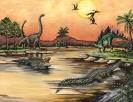The climate of a tundra:
It is cold through all months of the year Summer is a brief period of milder climates when the sun shines almost 24 hours a day. It has been called "the land of the midnight sun". But even the sun can't warm the tundra much. The short summer lasts only 6 to 10 weeks. It never gets any warmer than 45 or 50° F. The warmer weather causes a layer of permafrost, ice that never goes away in the ground, to melt, creating bogs and shallow lakes that don't drain. They breed stinging insects, which make life even in the summer miserable for the inhabitants of the tundra. The wind blows constantly, whipping around the small plants. During the long winter months the sun barely rises and it is dark for most of the day. Bitter cold winds scud across the barren snowscape, exposing high plateaus to barren ground. Winter temperatures don't reach above 20° F and average -20° to -30°F. Endless hours darkness settle in and the winds blow even harder. The snow that falls is blown off the high plateaus and collects in the valleys. Animals hunker down, able to find only enough food to keep warm. The tundra is an unusually cold and dry climate. Precipitation totals 6-10 inches of rain a year, which includes melted snow. This is almost as little as the world's driest deserts. Coupled with strong and drying winds, the tundra is an extreme weather biome. The tundra seems like a wet and soggy place because the precipitation that falls evaporates slowly, and because of the poor drainage caused by the permafrost. You can find the tundra climate in Köppen's E climate category. The Estands for ice climates. The average temperature of the warmest month is below 50° F. The tundra climate spans from most of Greenland to parts of Alaska, northern Canada, and northern Russia. The latitudinal range is 75° N to 60° N. Tundra climates can be found on the coastal areas of the arctic. The ocean water keeps the climate from falling to the extreme temperatures found in the interior of the continents.
The climate of a forest:
Tropical forests are very wet places, receiving heavy rainfall either seasonally or throughout the year. They are close to the equator and get lots of sunlight and warmth. Temperatures are uniformly high - between 20 and 35°C. They usually receive more than 200 cm rainfall per year.
The living things in tundra:
There are 1,700 species of vascular plants and only 48 land mammals can be found, although thousands of insects and birds migrate there each year for the marshes. There are also a few fish species such as the flatfish. There are few species with large populations. Notable animals in the Arctic tundra include caribou (reindeer), musk ox, arctic hare, arctic fox, snowy owl, lemmings, and polar bears (only the extreme north).
The living things in forest:
Flowers like orchids and bromeliads (members of the pineapple family) grow directly on trunks and larger branches - they are called epiphytes. Birds and butterflies insects easily reach these flowers and act as pollinators. Where rain falls all year round, the forests are evergreen - the trees do not lose their leaves, or do so at different times.
Friday, February 19, 2010
Subscribe to:
Post Comments (Atom)

No comments:
Post a Comment